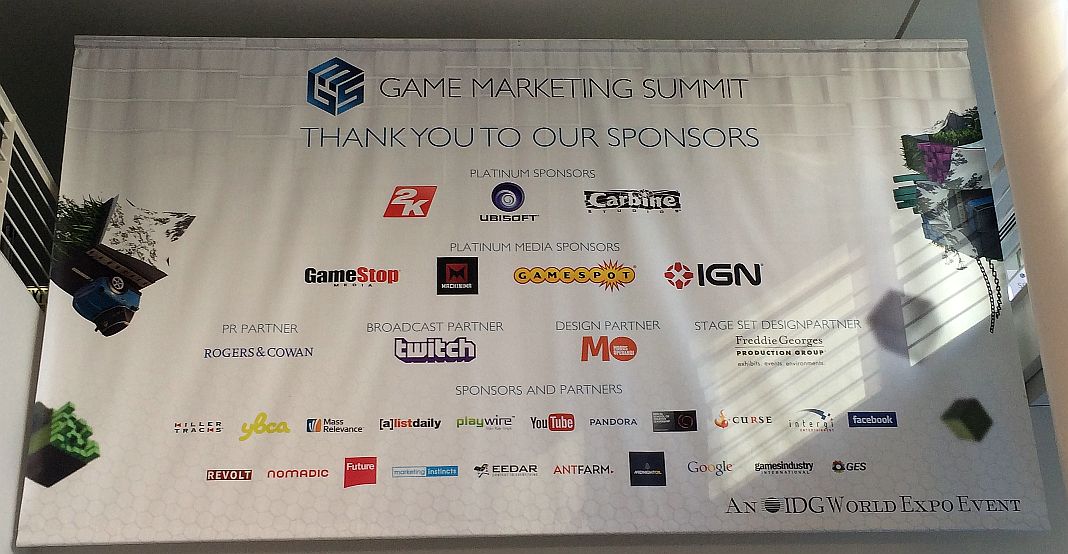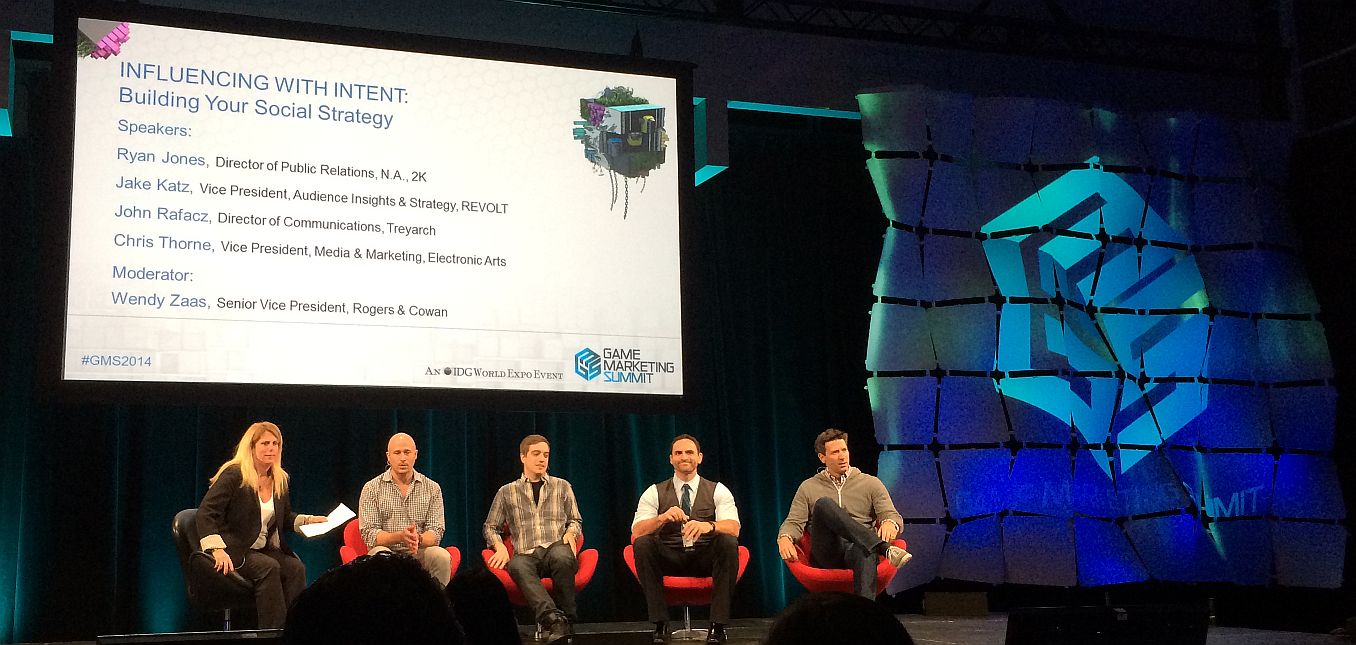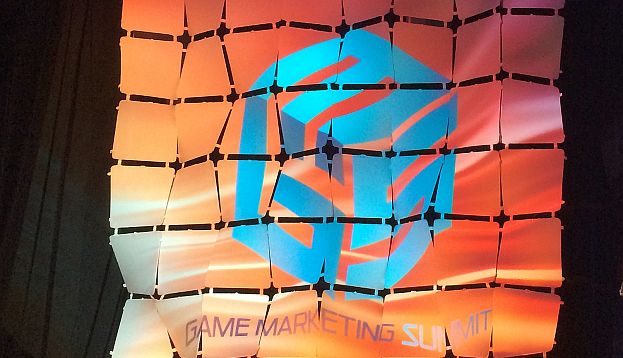The game industry’s marketers gathered at the 2014 Game Marketing Summit in San Francisco yesterday for a day packed with interesting speakers and networking, capped with the Game Marketing Awards. The event was focused on the changing landscape of game marketing, and some of the top marketers in the game business explored what’s changing and how marketers can take advantage of the opportunities afforded by these changes.
Carolyn Feinstein, SVP Global Consumer Marketing for Electronic Arts, and the co-chair of the GMS board of governors, started off by saying “I’m pretty sure I’ve never been on a stage with this many women at a gaming event.” At least in one area of the game industry there’s a good gender balance. Feinstein went on to note that the massive changes in the game industry from digital ,mobile, livestreaming and more, requires changing tactics and strategies to engage consumers and drive business.
Brian Cooley, CNet’s editor at large, used his keynote address to present a series of technologies to watch for the near future: Wearable tech, connected cars, connected home, the next billion mobile customers, and television. Cooley noted that smartwatches, fitness devices, and what he called “glassware” are all likely to be major categories, driven by a growing array of inexpensive sensors. The smartphone will be an important hub device for all of these wearables, and thus games may be able to take advantage of some of these platforms and their capabilities.

While connected cars and connected homes don’t hold much potential for game makers, the drive to get the next billion people on mobile devices does, as the $25-$50 smartphone arrives with tremendous impact around the globe. Finally, while 4K TV just represents an image quality upgrade (similar to the difference between DVD and Blu-ray), the potential for TV content to be delivered “over-the-top” instead of bundling into cable packages is already affecting the Xbox One and the PS4, as Microsoft and Sony begin producing original content.
Next up was a panel on Livestreaming: Your Next Generation Marketing Platform, with SOE president John Smedley, Marcus “djWheat” Graham of Twitch, and Bart Koenigsberg of Hi-Rez Studios discussing the vast impact livestreaming has had. ” It’s nothing short of a revolution,” proclaimed Smedley, noting that SOE is investing heavily in livestreaming. Graham talked about the impact of Twitch Plays Pokemon, and how the developers of Daylight were inspired by that to include some crowdplay features in their upcoming game. Streaming continues to expand, and as Graham points out, “It really is easy — the fact that we’ve had 5,000 to 10,000 streamers shows that.” The panelists agreed marketers should jump on livestreaming. “Embrace it, and embrace it now,” advised Smedley. “Where else are you going to find this concentration of qualified and interested buyers ,” Koenigsberg asked rhetorically.
The keynote address on creating contagious content was fascinating, given by Wharton Business School marketing professor Jonah Berger. He gave an overview of the ten years of research that went into his book Contagious: Why Things Catch On, and discussed the science behind creating viral content. He boiled down his findings to six key STEPPS: Social currency, Triggered, Emotion, Public, Practical value, and Stories. As he put it, the goal should not be getting 10 million views on a viral video, but getting ten to twenty percent new customers. He noted that word of mouth can be up to ten times more effective than advertising, and gave examples of how this works in practice. It’s important to note that while we often focus on online channels, most of our actual communication with others is offline — only about 7 percent is online (perhaps 10 percent in younger people). More info can be found at his web site, and it’s well worth a look.
The panel on Gaming Evolved: The Changing Landscape went right to the heart of what this year’s Game Marketing Summit was all about. Panelists Tony Key, SVP of sales and marketing for Ubisoft, Guy Longworth, SVP of PlayStation brand marketing for SCEA, and Albert Penello, head of product planning for Xbox, discussed the topic with Greg Short, the chairman and cofounder of EEDAR. The panelists noted that despite the increasing importance of digital distribution, retail continues to be primary. “I still have to create demand for that product,” said Key. “The distribution mechanism is not changing that, and it’s not helping me make cheaper games.” The panelists agreed that blockbusters will still drive sales in the future, though indies are of increasing importance — it’s the mid-range publishers that have disappeared. “There are no AA publishers any more,” said Key.
The next keynote, Marketing Worth Sharing, was delivered by marketer/cartoonist Tom Fishburne, CEO of Marketoon Studios. Naturally, his talk was copiously illustrated by cartoons, and he talked about why it’s never been a better time to be a marketer. The technology available is fantastic, Fishburne pointed out, but “we get excited about technology and sometimes forget about the big idea.” He noted some important things to keep in mind while crafting marketing strategy and tactics: Technology can’t save a boring idea, but it can amplify a remarkable one, Fishburne said. Preach to the choir, and don’t try to appeal to everyone. He also said that these days, “Everyone works in marketing.” Get ideas from all parts of the company, and you may find some surprising successes.

The panel on Influencing with Intent: Building Your Social Strategy included EA VP of media and marketing Chris Thorne, 2K’s director of PR Ryan Jones, Revolt’s VP of audience insights and strategy Jake Katz, and Treyarch’s direcotr of communications John Rafacz, moderated by Rogers & Cowan’s SVP Wendy Zaas. “Marketing is going to change more in the next five years than it has in the last 100,” said Zaas, leading off. The environment has changed the relationship between customers and companies, and it’s still shifting fast. How do you create strategies in that context “Most of the time we don’t have a strategy, we just have a conversation,” said Katz. “We don’t have the luxury of enough time.”
The final panel was The Persistent Dialogue, about communicating with gamers 24/7. Mike Lu, VP of product for Gree, was joined by John Heinecke, senior director of global brand management for Blizzard, and Lincoln Hershberger, VP of product marketing for Electronic Arts. Hershberger pointed out how they have integrated the messaging approach for both the community and PR teams. While Gree is new to building community teams, they have some special customers to pay attention to. ” We have guys who have formed groups of twenty or thirty who have spent more than $1 million in our games,” said Lu.
The importance of streaming is growing. “Hearthstone became the #2 game stream on Twitch because beta keys were so rare,” Heinecke said. “It’s a way to learn the game. Major crowdswell happened because of that.” Heinecke talked about the importance of the community and the company’s responses. “We look at marketing as inviting people into the Blizzard family,” Heinecke said. “You have different types of people in the family. You have to listen to all of them because there’s passion behind everything, they wouldn’t be posting if there wasn’t. You have to listen but not necessarily respond.”
The Game Marketing Summit for 2014 was an important and useful day for game marketers. Key takeaways from the sessions are that massive changes have occurred in game marketing and will continue to occur. Livestreaming is not just a consumer phenomenon, it’s becoming an important marketing tool as well. User-generated content is not just something that occurs in games, but we’re seeing it occur in marketing as well — those livestreams of game playing, or YouTube videos discussing game strategies, those are marketing that’s arising from the community. The pace of marketing is picking up so much you can think of it as real-time marketing, without the leisure time to plan out long campaigns you have to jump in and make things happen. As with games, marketing not just one shot — marketing needs to be a continuing process, just as games have become a service in many cases. You can’t count on just one thing — keep marketing!

